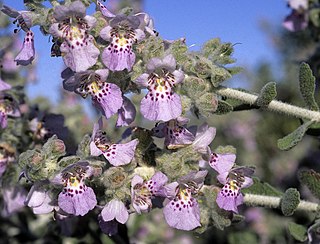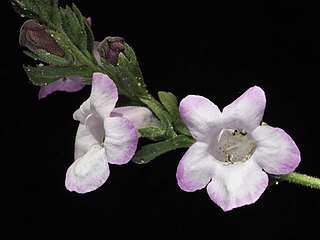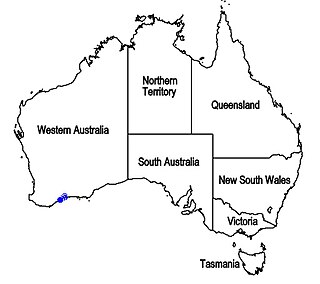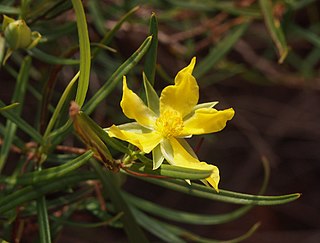
Eremophila dichroantha, also known as bale-hook eremophila, is a flowering plant in the figwort family, Scrophulariaceae and is endemic to the south-west of Western Australia. It is a shrub with many ascending branches making the plant appear broom-like. It has small, hooked leaves and small, though abundant, violet to lilac-coloured flowers.

Eremophila weldii is a flowering plant in the figwort family, Scrophulariaceae and is endemic to Australia. It is a shrub with glabrous green leaves, small sepals and purple or lilac-coloured petals and it occurs in arid and semi-arid areas of Western Australia and South Australia.

Eremophila densifolia is a flowering plant in the figwort family, Scrophulariaceae and is endemic to the south-west of Western Australia. It is usually a low, spreading shrub with densely clustered leaves and lilac to purple flowers.

Eremophila psilocalyx is a flowering plant in the figwort family, Scrophulariaceae and is endemic to Western Australia. It is an erect shrub with a broom-like shape, narrow, hooked leaves and white, pink, blue or purple flowers. It is common in the mallee country around Esperance. It was sometimes incorrectly known as Eremophila pachyphylla.

Quoya atriplicina, commonly known as saltbush foxglove, is a flowering plant in the mint family Lamiaceae and is endemic to Western Australia. It is a bushy shrub with its branches and leaves densely covered with a layer of hairs, giving them a greyish appearance. The leaves are broad-elliptic to almost circular in shape and the tube-shaped flowers are pink with purple spots inside.

Quoya oldfieldii, commonly known as Oldfield's foxglove, is a flowering plant in the mint family Lamiaceae and is endemic to the south-west of Western Australia. It is an erect shrub with its branches and leaves densely covered with a layer of brownish hairs. The leaves are egg-shaped and the tube-shaped flowers are pink with purple spots inside.

Dasymalla teckiana is a flowering plant in the mint family Lamiaceae and is endemic to Western Australia. It is a small, openly branched, sticky shrub with mauve and white, bugle-shaped flowers.

Pityrodia lepidota is a flowering plant in the mint family Lamiaceae and is endemic to the south-west of Western Australia. It is a small, densely-branched shrub with small leaves and whitish, bell-shaped flowers. The entire plant, apart from the petals, is densely covered with small, circular scales.

Hemiphora elderi, commonly known as red velvet, is a flowering plant in the mint family Lamiaceae and is endemic to the south-west of Western Australia. It is a small shrub with its leaves densely covered with white, woolly hairs and with small clusters of reddish-purple, bell-shaped flowers.

Quoya dilatata is a flowering plant in the mint family Lamiaceae and is endemic to Western Australia. It is a low, spreading shrub with its branches and leaves densely covered with a layer of white, woolly hairs. The leaves are wrinkled or crinkly and the tube-shaped flowers are orange-red and hairy on the outside.

Pityrodia chrysocalyx is a flowering plant in the mint family Lamiaceae and is endemic to the south-west of Western Australia. It is an erect, bushy shrub with small, glossy leaves, and flowers with white petals and a golden-yellow calyx.

Hemiphora exserta is a flowering plant in the mint family Lamiaceae and is endemic to the south-west of Western Australia. It is a sprawling shrub with its branches densely covered with white, woolly hairs. Its leaves are rough and wrinkled and the flowers are deep pink or dark red, curved and tube-shaped with spreading petal lobes on the end.

Hemiphora uncinata is a flowering plant in the mint family Lamiaceae and is endemic to the south-west of Western Australia. It is an erect, spreading shrub with its branches densely covered with white, woolly hairs. Its leaves are rough and wrinkled and the flowers are tube-shaped with deep pink petals with wavy edges.

Quoya loxocarpa is a flowering plant in the mint family Lamiaceae and is endemic to Western Australia and the Northern Territory. It is an open shrub with many spindly tangled branches. The leaves are oblong and woolly when young and the flowers are whitish pink with purple spots inside and are surrounded by woolly sepals.

Pityrodia hemigenioides is a flowering plant in the mint family Lamiaceae and is endemic to the south-west of Western Australia. It is a spreading shrub with densely hairy branches and leaves, and pale white flowers near the ends of the branches.
Quoya paniculata is a flowering plant in the mint family Lamiaceae and is endemic to Western Australia. It is a shrub with its branches and leaves densely covered with a layer of woolly hairs. The flowers are usually arranged in small groups surrounded by woolly hairs and are bell-shaped and deep purple or deep lilac. It is similar to Dasymalla axillaris and D. terminalis but is distinguished from them by its wedge-shaped leaf ends and more northerly distribution.

Quoya verbascina, commonly known as golden bush, is a flowering plant in the mint family Lamiaceae and is endemic to Western Australia. It is an erect shrub with its branches and leaves densely covered with woolly hairs. The leaves are often oblong but very variable in shape and the flowers are pinkish-white with pink spots inside and are surrounded by yellow woolly sepals.

Leucopogon plumuliflorus is a species of flowering plant in the heath family Ericaceae and is endemic to the south-west of Western Australia. It is a weakly erect shrub with egg-shaped leaves and spikes of white or pinkish-white, tube-shaped flowers.

Leucopogon tamminensis is a species of flowering plant in the heath family Ericaceae and is endemic to the southwest of Western Australia. It is a slender shrub with many branches, overlapping triangular to egg-shaped leaves and white, tube-shaped flower arranged singly in upper leaf axils.

Hibbertia glaberrima is a species of flowering plant in the family Dilleniaceae and is endemic to Central Australia. It is a glabrous, spreading shrub with oblong to lance-shaped leaves and yellow flowers borne singly in upper leaf axils, with 30 to 150 stamens arranged around three carpels.




















